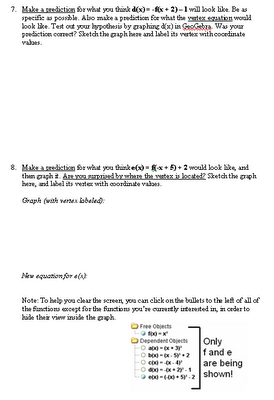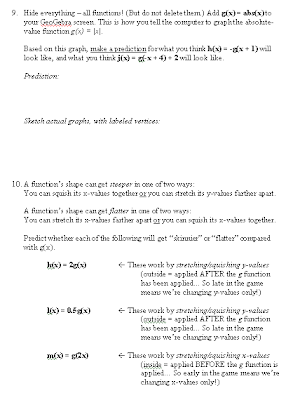But, in reality, (it being my first year teaching Precalculus,) I am struggling with making Precalculus accessible for every kid. The good thing is, they're learning at the level I would expect -- a little slowly, and usually it takes us several days to get through one dense section in the textbook, but the kids at the top of the class are understanding everything on the exams, and the kids at the bottom are working steadily in class in groups, through all of the problems, with some help from me. No one is drowning. Yet.
But they're moving more slowly than I need them to, even just through the "review" (Algebra 2-ish) material, and at the rate we're going, we're not going to have much of a chance to do much of trig identities this year! ugh. Everything we do, it feels like we're doing from scratch with more or less zero retention from years prior. The kids whom I had taught last year are picking up more or less right from where we had left off, and sprinting forward with minimal discomfort. The rest of them are struggling with basic things, like on Friday during a quiz a kid was struggling with what a rectangular prism looks like, even though we had done various volume-maximizing and surface area-minimizing practice problems in class (and also area-maximizing and perimeter-minimizing problems with 2-D shapes). Another new kid who recently transfered to my class had to be taught how to look at a function equation to figure out what quantities the x and y represent. His past teachers had NEVER explicitly asked him what x and y stood for before. EVER! (So, when he found the maximum point (5, 368), for example, he had no idea what those values meant.)
I feel somewhat discouraged. I think they are learning, because they're working very hard in class everyday, and I am pacing the material slowly enough for it to be absorbed piecewise. But, it seems like I am having to teach them how to run when some of them can still barely walk. (It's already halfway through the year, and every time they see a new word problem, half of the class's attitude still is, "I don't know how to do this!" without having drawn diagrams, made tables, or really even attempted to set up any equations. In terms of persistence, they're miles behind my regular 9th-graders.) With the end of the year so quickly approaching, I just wonder if I am doing/will be able to do enough before June to prepare them for their future classes.
sigh. The scariest thing is that if we don't struggle with these "small" details now, they could very well get to Calculus, do a bunch of differentiation and maximization/minimization, get some x value, and have no clue what that means. SCARY!!!!!!! So, my taking some extra time with them is (sadly) absolutely necessary. But, it just seems... exorbitant.
------------
Anyway, recently we've started looking at function transformations in Precalc. I created an activity meant to introduce kids to the basics of transformations via GeoGebra, and I really wasn't sure how it was going to pan out. It was long -- we had a 50-minute class on Friday, and most kids only got a little over 2/3 of it done. We're going to finish it on Monday, and then ease our way into practicing graphing by hand with "irregular" base functions drawn in the textbook.
Here it is. Check it out! I was actually extremely pleased with how it went in class. Kids (working in pairs) were making actual predictions every step, then verifying their predictions via GeoGebra, and asking me questions if/when they couldn't figure out why their prediction was incorrect. Lovely mode d'etre! And, as it turns out, GeoGebra is a super nice tool to use for this activity, because it allows you to define some base function (say, f(x)=x^2), and then to define other functions in terms of f. ie. a(x) = f(x + 3). Once both functions show up on your screen, on the left side you can see the vertex form of the dependent function. I think this ability to define functions in terms of other functions really helps to generalize their transformational understanding, right from the start, to any form of base function.






Thoughts? (In this introductory activity they only explore effects of transforming quadratic, absolute-value, and square root functions. But, my hopes are that they can then transfer this understanding to the other function types.)
Wow! very cool. Great handout. This is a lot to imagine doing in one session! I'm also interested that you seem to be organizing this by what function you're transforming rather than by the transformations themselves.
ReplyDeleteMe, I'd start with slides in both directions, then move to vertical stretch and squish, and only later get to horizontal stretch. And I'd do each transformation with various functions before moving to the next transformation. Personal preference, probably.
As to the tech, I don't know GeoGebra (and I know you're budget-constrained and familiar with that program) but I do this with Grapher, Sketchpad, or (my favorite) Fathom, in which you can create a slider for each parameter so that the kids see the function change as the parameter changes. (I have no evidence that this actually helps, but I believe it does. If GeoGebra would let you do this, it might be worth a try.) When you see it, and change the parameter yourself, you get a visceral feel for how (for example) changing H moves the function back and forth in
y = (x - H)^2
Another way to think of this "dynamic" approach is that it lets the students see hundreds of functions with particular properties, the same way that dynamic geometry lets kids see hundreds of (constrained) figures as they drag stuff around.
Since you’re teaching Pre-Calc for the first time, I would keep track of all of these gaps in prior knowledge that you notice as well as the prevalence of each gap, i.e. whether 2 out of 25 students have forgotten/never learned the concept or 10 out of 25. Because the greater the prevalence, the more likely that you’ll run into those same gaps again next year with a new batch of students. I would absolutely love it if you could share more of those gaps that you’ve noticed as being quite prevalent for Pre-Calculus as well as for your other courses, both honors and regular. I remember the first time I realized that Algebra 2 students had no clue how to complete the square because the Algebra 1 teachers were enamored with teaching the quadratic formula song to Pop Goes the Weasel, or that algebra 1 students couldn’t add fractions because the middle school teachers had them convert the fractions to decimals instead.
ReplyDelete@bestcase: Organizing it by functions was a natural choice for me, since the kids are most familiar with quadratics and second-most familiar with absolute value functions. I was moving them gradually away from things they were familiar with into less familiar realm...
ReplyDeletePersonally, I prefer to break it down by functions instead of having a "slider" activity like you suggest, because it forces the kids to spend more time thinking about every transformation (versus as soon as they see the pattern using a slider, the thinking stops and so does the permanent memory-building). GeoGebra definitely supports sliders, by the way, and they're quite easy to make/use/even animate!
@Paul: I always keep track, whether mentally or otherwise. I don't keep stats like how many kids per class (but that's more because in general I am very disorganized with data-keeping). I'll try to report back at the end of the year if I think there is any interesting analysis to be made!